I am of an age when I remember phones being phones, housed in boxes at the end of the street, hard to believe that our house didn’t have a phone until I’d left home. Maybe that was a strategic decision on my mum’s part, but as a youth I dreamt of having a communication device. One that would allow me to talk to my mates any time I wanted – or even better would transport me to the pub!
It would have been the coolest, most space-age (remember that phrase?) device ever and would have gone well with my parka, Ben Sherman shirt and scooter. Yep, the mods deserved a cool gadget like that, but it never came. My phone would have been full of some great pics, and I am sure someone would have created a Lambretta app – full of tips on how to customize our beloved machines. And as for the little black book…
Technology has a cruel habit of creeping up and eventually overtaking us and one eye over your shoulder is a wise strategy. Smartphones are relatively new but already they are becoming the most indispensable gadget we have – although I do know a few Luddites that refuse to have them.
Calling them a gadget is almost demeaning what they are – no-one regards a computer as a gadget – or a sat nav – or a camera – they are tools and that is exactly what a smartphone is. Going further, it is a toolbox. We are constantly finding uses for its cleverness, but its greatest talent is also its oldest and most fundamental; communication. We are the most communicative species on the planet and smartphones are great communication tools.
So what has a smartphone got to do with direct marketing and catalogues in particular – well this headline should make you sit up:
“77% of smartphone owners still use catalogues to browse proving that integration of all channels is key for success.”
See the full story here: http://bit.ly/VFmKor
It’s not hard to see why the smartphone is so invaluable – but the surprising part of this is how the catalogue still has a part to play in the purchasing process. The most ardent fans of digital still like paper and the high street is suffering where the smartphone is stepping in.
QR codes are widely used in all forms of direct mail – and in general advertising – they are pretty ugly things visually, but their ability to extend the reach of a catalogue is outstanding. Add in augmented reality and the wow factor just resounds along with the clicking of mental cogs; this is the link between digital and paper. But all these are doing is communicating a message – and extending the power of that message.
Just look at this: http://bit.ly/P8gqhD
You are seeing a world that’s doesn’t exists – except in your smartphone or tablet – but the ticket to getting there is a catalogue.
And this is just the start. A client of mine put a picture of a muddy footprint on the desk during a meeting. He then told us to download an app and look at the ‘footprint’ through the phone. The footprint then became a 3D muddy boot that I could explore – look inside and almost touch – wow! It was truly amazing.
Think how this extends the catalogue reach. Equally we could have looked at this with a tablet, the effect would have been even more amazing. Think how cool it would be to look at this product and then click the ‘Add to Basket’ button. One simple process; the vehicle and channel working seamlessly.
So where is this going? The whole point of this is to demonstrate that even with new technologies hogging the stage – the oldest form of direct mail still has a part to play. Magazines are now embedding codes invisibly into pictures that trigger movies on smartphones. As we see above, Ikea is using this same technology in catalogue – and it will become routine. The integration of paper and digital will become increasingly closer, but even without the clever stuff, catalogues can still extend your reach. The under 30’s are one of the most responsive to direct mail and catalogues, we just need to engage them. Equally smartphone reach is extending into older age groups, we just need to be creative in the way we bring together our direct marketing channels. But weren’t we saying that long before the smartphone came along? Beam me up Scottie…

